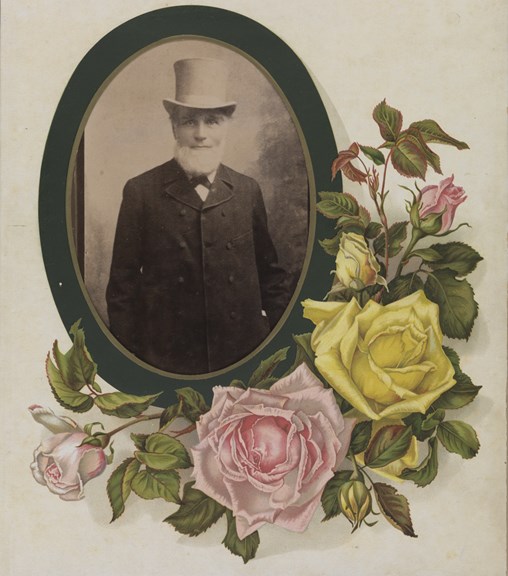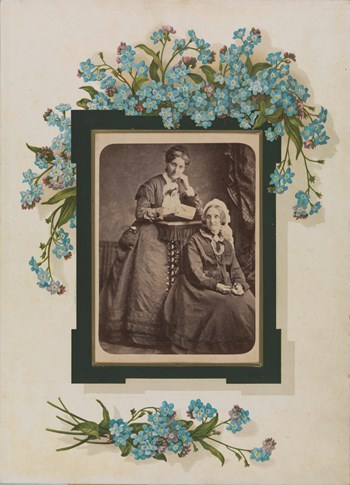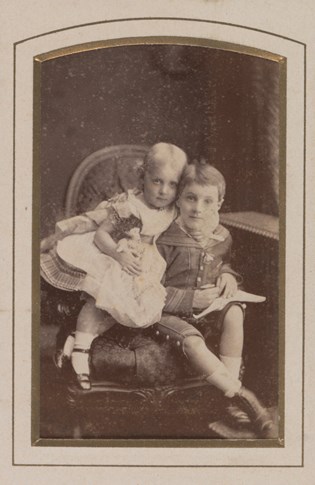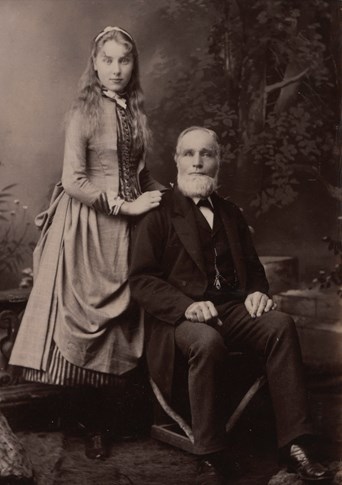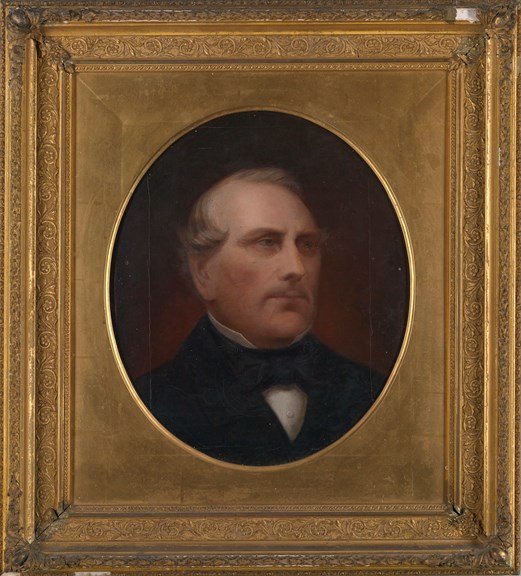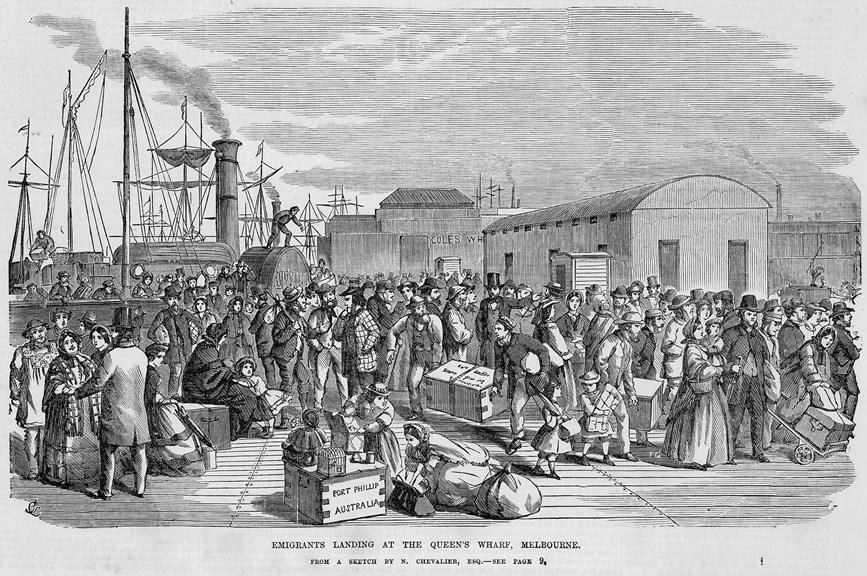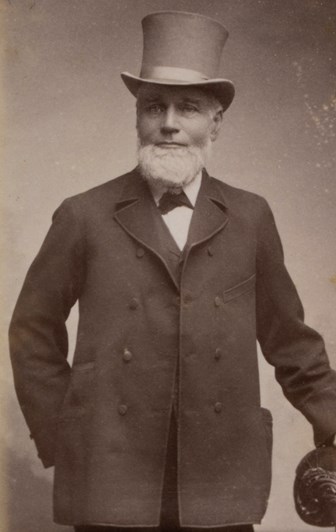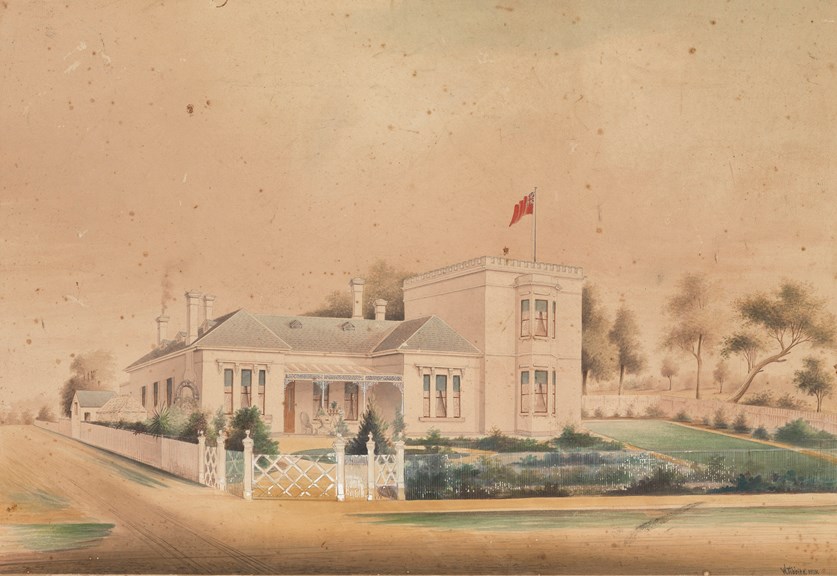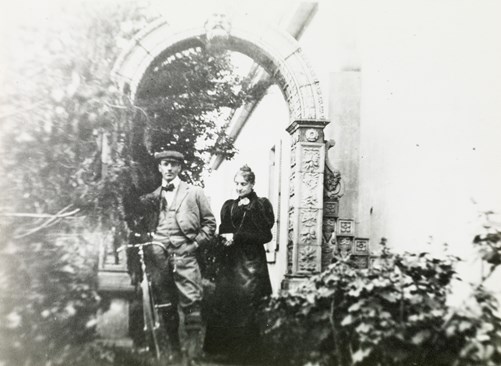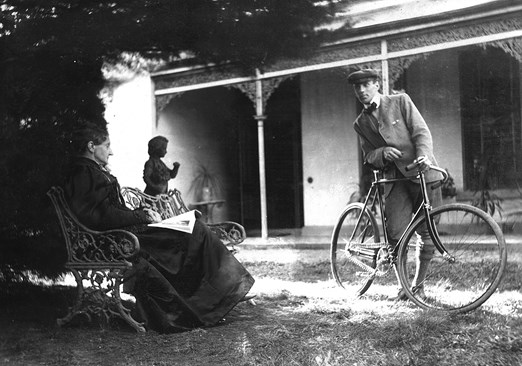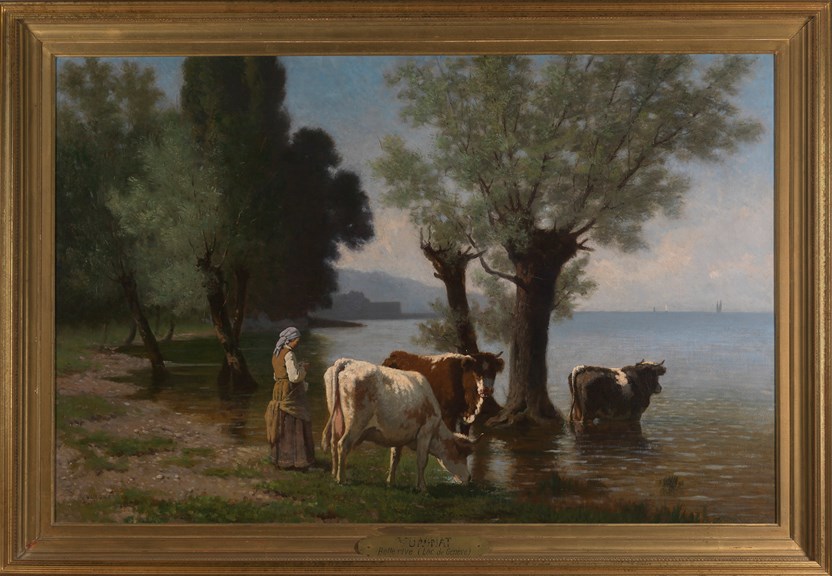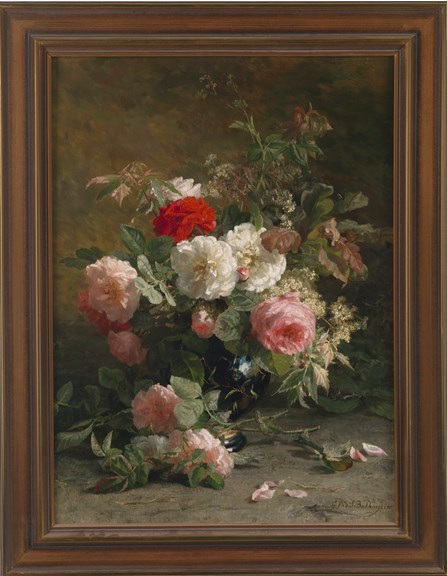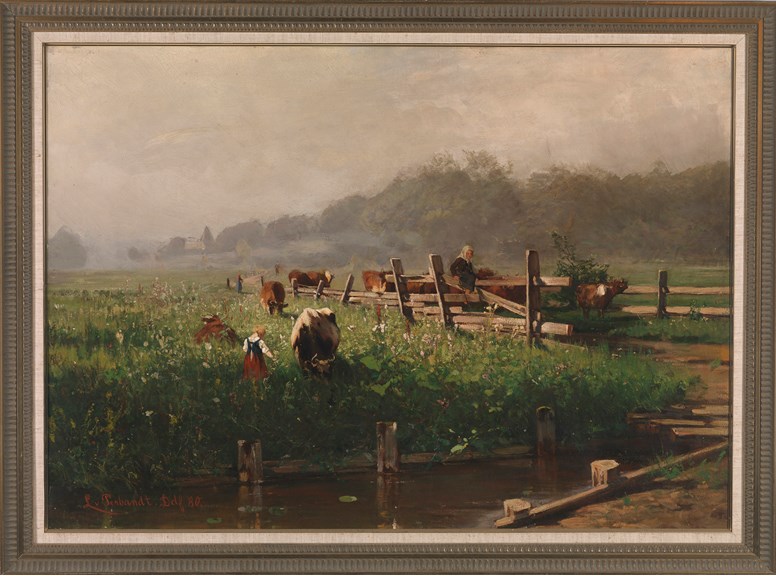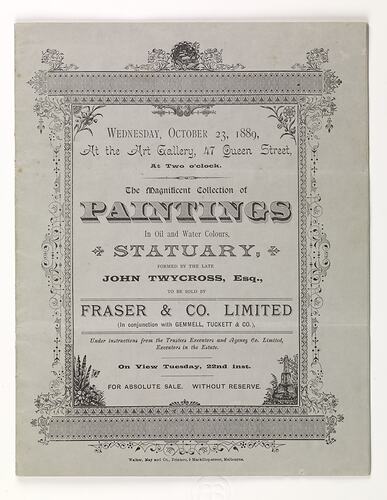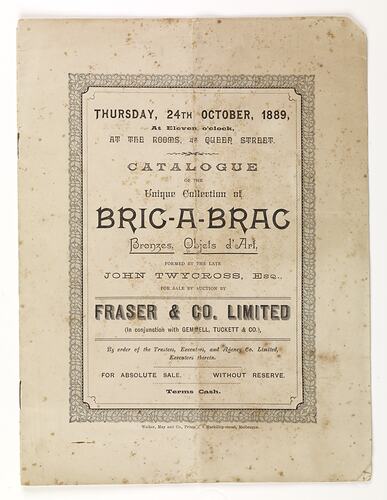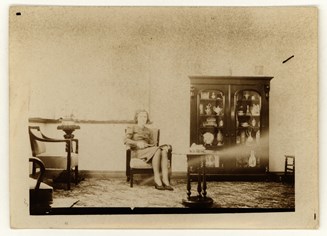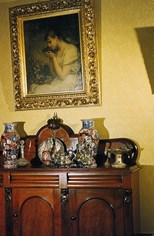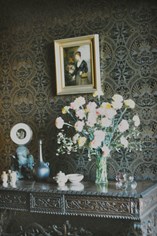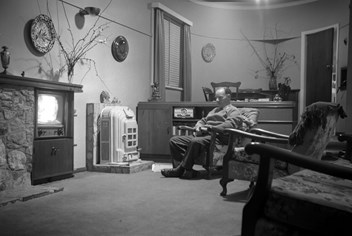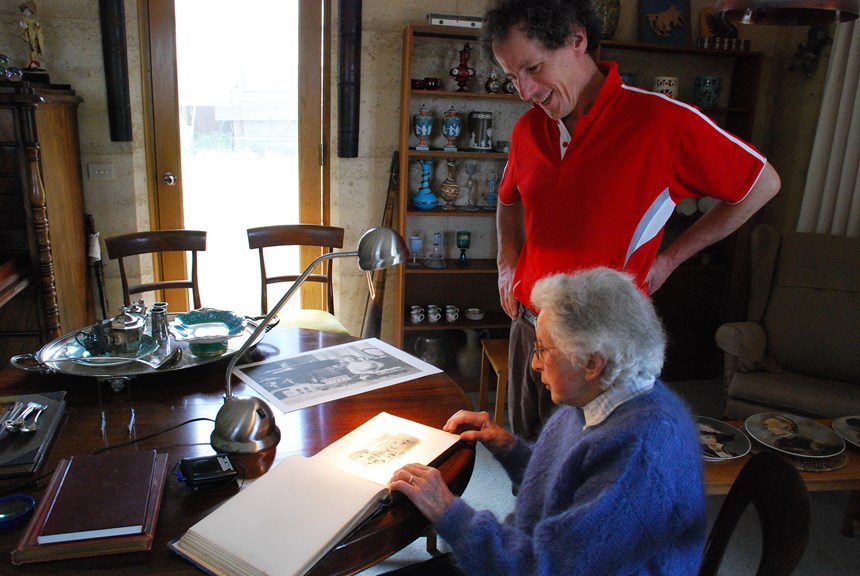The Collectors
John Twycross had already started collecting before he was married. By 1869, he had at least seventeen works of art which he lent to the exhibition of Works of Art, Ornamental and Decorative Art held at Melbourne's Public Library between March and June that year.
John and Charlotte ('Lizzie') were married the following February, at Lizzie's family's extensive property at Arthur's Seat, near Frankston.
When John died in 1889, the responsibility for the collection passed to Lizzie. She put a large portion of it up for sale, but equally kept several hundred objects for her family; two children from her marriage with John, and two children from an earlier marriage to Samuel Henry Clutterbuck.
What she kept, and what she passed on to her children, says a lot about Lizzie. It reveals what she liked, what she appreciated and, having moved to a smaller house, what she was able to keep.
The collection donated to Museums Victoria is an important one, not only for illustrating the types of art objects available at Melbourne's International Exhibitions, but for what it reveals about the personal collecting tastes of the Twycross family. Over four generations, the family has treasured and valued the collection, displayed it, carried it with them to different addresses, and finally gifted it to the Museum so that the family legacy will continue in perpetuity.
The Twycrosses of Wokingham
James Twycross was a strong man: devout, firm in his opinions, capable in the way he approached his business and civic roles, and committed to his large family of twelve children. One of his grandsons would later write that he 'was a man of splendid physique and could hold at arms length a weight of 30lbs in each hand at the same time', a feat of strength that obviously left an impression.
James was born in Godalming, Surrey, England, around 1790, into a family of fellmongers and tanners who dealt in the preparation and processing of sheep and cattle hides. James followed the family profession, as did his sons.
In December 1812, James married Mary Howell in the Berkshire town of Wokingham, about fifty kilometres west of London. The couple's eldest son, George, was baptised in the parish church of All Saints' in 1813, while the family were still living in nearby Eversley, a village to the south west of Wokingham, in Hampshire. It was here that several more children were born, including John Twycross in 1819.
James moved the family to Wokingham in 1820 to a large, two-storied brick house, south of the town's centre. He named the family's new home The Brook, after the small river Emm Brook that ran across the bottom of the property.
By the 1840s, James Twycross and his sons were well established as fellmongers, tanners and woolstaplers, dealing in the processing of animal hides and the sale of wool. A decade later, James Twycross & Sons had expanded still further. The business was thriving, with James Twycross employing 43 workers. A further 36 men were employed through the firm's branch in Bradford. John Twycross, now in his late twenties, played an active role as a tanner at the Twycross tanneries on Barkham road, Wokingham.
... myself and my three sons have been engaged of late in a business, conducted by two of my sons in Australia and one at Wokingham, as wool and general merchants ... Our shipments to Australia have been heavy, and upon our import and export trade we more particularly depend.James Twycross, letter to the Reading Mercury, 19 May 1857
James Twycross was a respected business man and influential figure in Wokingham by the 1850s. In 1856, he was appointed a member of Wokingham's council, and in April 1858 he became the town's Alderman, a role with responsibilities similar to those of a mayor. At the conclusion of his term, the council minutes recorded their unanimous thanks to Twycross 'for the efficient manner in which he had displayed the duties of Alderman during the past year'.
James died on 3 December 1862 at the age of 67, to 'the irreparable loss of his sorrowing family'. For five years, his sons would carry on the family business, both in England and Australia, before John Twycross decided to commence his own commercial ventures in Melbourne.
Arriving in Melbourne
34-year-old John Twycross arrived in Melbourne aboard the steamship Harbinger on Friday, 23 December 1853, with his brother James and sister Anne Sophia. In the ship's hold was a pre-fabricated house they had brought with them from England. The Twycrosses had come to settle in Australia.
The siblings soon rented a small, three-roomed weatherboard cottage in Richmond with a small wash house attached, but no garden. Property in Melbourne was in high demand following the discovery of gold in Victoria in 1851, and the siblings paid the princely sum of 3 pounds 15 shillings per week for their cottage. It was, as John wrote home to his sister, a monstrous amount but there were few alternatives.
We were just seven weeks on the water. You will say quite long enough to be tired of it. On the whole we had a pleasant passage the first fortnight. ... We anchored in the Bay which is about two miles from Melbourne it is only small vessels that can come up the Yarra to the wharf.John Twycross, letter to his sister Emma Milne, 26 February 1854
Arriving in summer, John found Melbourne's climate unbearable. Hot northerly winds swept the baked ground, filling the air with dust high above the trees so that even during the day it was as dark as night. 'Had I known what this place was like', he wrote back to England, 'the largest lump of gold in the land would not have brought me out'.
In Australia, John Twycross and his brother James commenced business as general merchants, catering to the demand for products essential to life in a new colony.
After several years in Australia, both Anne and James returned to England. Anne had married in Melbourne and had several children before returning home in the mid-1860s. She recalled her time in Australia fondly, as she named their new home in Sussex Yarra Yarra. James junior returned a few years earlier, to continue working in the family business as an 'Australian Merchant'. He never returned to Melbourne and he died in England in 1878.
John Twycross stayed in Melbourne, and prospered.
Man of means: business in Melbourne
From mid-1867, John Twycross ceased to be the Melbourne representative of the family firm of James Twycross & Sons, choosing instead to pursue his own commercial interests.
He opened a sheet lead and pipe factory in A'Beckett Street, Melbourne, employing manager Richard Coop to run the business. He also purchased a rope factory in Arden Street, North Melbourne, which was managed by foreman James Payne.
In 1871, John Twycross listed himself in Melbourne's trade directories as a wool merchant for the first time, an indication that his commercial interests had turned back to the family's original line of work in England. In all likelihood John had probably been involved with the wool trade for some years, for in 1869 J. Twycross & Sons had been recorded as one of the principal importers of Australasian wool, having brought in almost 1,400 bales.
John operated a tanning and fellmongery business (dealing in animal hides, often sheep skins), perhaps initially from the back of his premises in A'Beckett Street. The foul smells and waste associated with the business was not appreciated by his neighbours, as reported in The Argus: 'a heap of hides was found in a very bad condition ... the smell from which was loudly complained of in the adjoining lead works'.
The city of Melbourne is being extended in all directions. It has some very fine brick and stone buildings. Most of the streets are generally crowded, and the business done here is immense. Owing to the great number of persons daily arriving in the colony from nearly all parts of the world, and passing through Melbourne, to and from the diggings, it has always the appearance of bustle and confusion.John Twycross, letter to his sister Emma Milne, 26 February 1854
Following this negative assessment of his business arrangements, John opted to move his tanning operations outside the city limits. In 1873 he purchased the Hotham tannery (with an adjoining four-roomed wooden cottage) at Alfred Street, North Melbourne, from John Francis, and a two-acre block of land with a fellmongery and cottage on the Saltwater River (now the Maribyrnong River) in Footscray. In the Sands & McDougal trade directories, John is recorded as a fellmonger and tanner with premises at the Saltwater River site through much of the 1870s.
By the time of the 1880 Melbourne International Exhibition, after almost thirty years working as a merchant, fellmonger and tanner, Twycross was looking towards retirement. He is last recorded as a merchant in the trade directories in 1879. He sold the Alfred Street tannery a few years later. At almost sixty years of age, retirement gave John Twycross the opportunity to pursue his great passion for art collecting.
The 1880 Melbourne International Exhibition was an event like no other the colony had seen. For a collector such as John Twycross, the vast array of paintings, ceramics, glassware and other decorative arts on offer was an opportunity not to be missed.
Emmarine: home for a family and collection
On 9 February 1870, in a small, family ceremony at his future father-in-law's residence at Arthur's Seat, John Twycross married Charlotte 'Lizzie' Clutterbuck. She was the daughter of wealthy pastoralist Joseph Brooks Burrell, who owned vast tracts of land along the Mornington Peninsula.
It was Lizzie's second marriage. She had married Samuel Henry Clutterbuck in 1853. Before his untimely death at the age of 34 in 1861, Lizzie and Samuel had two sons who survived infancy, Arthur William DAgnall (b 1857) and Alfred Charles Ernest (b 1860). After John Twycross' death in 1889, Lizzie's sons by her first marriage inherited objects in the Twycross' collection, items that were passed through the family and are still retained by their descendants today.
In 1871, Lizzie and John's first child John William Twycross was born at their home on Alma Road in St Kilda. Within a couple of years the family moved into a grand, single-storey, 13-room brick house they had built on the corner of Glenhuntly road and Beavis street in Caulfield. They called it Emmarine. In 1874, John and Lizzie's second child Ida Lilian Kate (known as Lilian) was born.
Part of the reason for the family's move may have been to afford more room to John Twycross' growing collection of art works. By 1869 he had already amassed a collection of sufficient size to enable him to loan 17 paintings to the Exhibition of Works of Art, Ornamental and Decorative Art held at the Melbourne Public Library.
When Emmarine was built, Twycross had a two-storey 'art gallery' built on the house's eastern side to accommodate the art works. He called it the 'Turret Room'. When Emmarine's 'portrait' was painted in 1875 by the well-known architectural artist William Tibbitts, the art wing was readily apparent, towering over Glen Huntly road.
A growing collection
Melbourne's National Gallery was only eight years old when it held its first loan exhibition: Works of Art, Ornamental and Decorative Art. Opened by Sir Redmond Barry in late March 1869, the exhibition included 17 works from the collection of John Twycross.
In 1873, John Twycross became a life member of the Victorian Academy of Arts (later the Victorian Artists' Society). The following September he was appointed an office bearer of the Art Union of Victoria; established in 1871, it was based on the popular British Art Unions where for a small subscription fee members were entered into a lottery to win works of art.
But it was the 1880 Melbourne International Exhibition that provided a rich and unique opportunity for John Twycross to expand his collecting habits.
The Exhibition opened in October 1880, and by the end of January 1881 Twycross had already purchased at least two large oil paintings from the French Court, Francois Vaugnat's A Bellerive (At Bellerive, Lake Geneva) for £64 and Leon Barillot's Le gue' de las Landies (The Ford at Las Landies) for £100.
By the time the Exhibition closed at the end of April, Twycross had purchased a further six paintings from the French Court, amounting to £645, in addition to numerous other examples of fine porcelain and ceramic ware, bronzes, glassware and other decorative arts. Twycross' substantial collection now filled the purpose-built art 'tower' at Emmarine, and adorned every wall and shelf in the house.
That he purchased extensively from the Exhibition is indicated by the later auction sales of parts of the collection in August 1888, in which Melbourne auctioneers Gemmell, Tuckett & Co. advertised 'the 'magnificent gallery of paintings of J. Twycross, Esq.' Including 'some valuable works, purchased from the French and German Courts at the Last Melbourne Exhibition'. Likewise, Twycross' 'valuable collection of art china, bronzes and bric-a-brac ... mostly purchased at the Last Exhibition of 1880'.
The 1880 Melbourne International Exhibition provided Twycross the opportunity to make connections with dealers and artists alike. One such artist was Geraldine van de Sande Bakhuyzen (1826-1895), the daughter of artist Hendriks van de Sande Bakhuyzen and a skilled artist in her own right, particularly in the still life genre. She exhibited one work, Roses, in the Netherlands Court at the Exhibition, which Twycross purchased.
Twycross loaned several paintings to the Victorian Jubilee Exhibition in 1884, and shortly afterwards contributed an oil painting, Dromana from the Bay by an unidentified artist, to the Victorian Courts exhibits for the Colonial and Indian Exhibition held in London in 1886. Like all participants at this Exhibition, John was presented with a medal that is still retained by the family. Two years later, John Twycross lent three oil paintings to the Victorian Loan Collection at the 1888 Melbourne International Centennial Exhibition. His photograph is included in one of the four large albums of exhibitor and staff identification portraits, alongside fellow exhibitors in the Victorian Artists Gallery, the young Australian Impressionist artists Tom Robert and Arthur Streeton.
The 1888 Melbourne Centennial International Exhibition was the last major opportunity for John Twycross to either exhibit, or buy further works for his collection, though his awareness of his ailing health probably discouraged him for any major new acquisitions. He died the following May, a little over three months after the Exhibition closed at the end of January 1889.
Off to auction
Throughout the 1880s, John Twycross began to disperse his collection through a number of auction sales.
These may have reflected a need to reduce the collection's size, a need for financial liquidity, or simply a fluid approach to collecting that saw collection items continually bought and sold as his tastes and interests changed.
Despite continuing to exhibit and acquire works as late as 1888, John Twycross' health was deteriorating. On 9 May 1889, he died at his home Emmarine on Glen Huntly Road, Caulfield, surrounded by the art collection he had spent more than twenty years accumulating.
Five months after his death, his large collection of paintings, statuary, bronzes and decorative art objects was put up for sale. Over two days at the end of October, Fraser & Co., in conjunction with the well-established auction firm Gemmell, Tuckett & Co., auctioned an impressive array of the Twycross collection at their Queen Street showrooms. The collection consisted of 155 paintings, sculpture, and Venetian furniture, followed the next day by 254 decorative art objects.
It was not the first occasion that the Twycross collection had been put up for auction. On at least three earlier occasions during the boom years of the 1880s, he had sold off parts of his collection. In May 1883, Fraser & Co. had sold a collection of Twycross' oil paintings and water colour drawings 'in consequence of his contemplated departure for Europe'; the planned trip never eventuated.
Further auctions followed in October 1884, and again in August 1888. Advertising the sale in 1884, Fraser & Co. noted that: 'The present well-known collection, which has taken many years to complete, comprises some of the finest watercolours that have ever been submitted for public competition in Australia. The many picture connoisseurs in Melbourne are earnestly requested to avail themselves of this opportunity of securing gems.'
The absolute dispersion of a collection formed by such a well-known expert ... affords an opportunity for patrons of art of acquiring pictures worthy of a place in any public or private collection.Argus, Saturday, 19 October 1889
In his art collecting, as in business, Twycross enjoyed a certain amount of speculation. Several items that had been sold at earlier auctions had evidently been reacquired by Twycross, for they were listed for sale again in 1889.
The Argus newspaper reported that there 'was a large attendance of connoisseurs, and such lot had keen competition.' But despite this, prices were not as high as might have been expected.
Emile Laporte's La femme du levite d'Ephraim (the wife of the Jew Ephraim), which Twycross had purchased from the French Court of the 1880 Melbourne International Exhibition, had already been put up for auction by Twycross in 1883, were it was sold to William Bridges for £142/10, a profit of £22/10 above the £120 Twycross had paid for the painting in 1880.
Bridges, whose sister had married Twycross' first cousin in England, owned a private art gallery in Melbourne and perhaps hoped to sell it, but failed to find a buyer. The painting was again included in the sale of Twycross' estate in October 1889, where it reached the disappointingly low sum of £53. It was one of three pictures Bridges had included in the estate sale of his late cousin-in-law.
However, not everything was put up for auction in 1889. While most of the paintings and larger items sold, Lizzie Twycross retained a representative collection of smaller items of ceramic ware, carved Japanese ivories, and other items acquired at the 1880 Melbourne International Exhibition.
Aftermath and legacy
During his lifetime, John Twycross built up an incredible wealth, visibly expressed in the grandeur of the family home, Emmarine, his extensive collection of art works and objects, and an incredible portfolio of investment property. When probate was granted for his estate in June 1889, it was valued at £39,918: a significant sum equivalent to several million dollars in today's terms.
Alongside the sale of Emmarine, his executors would advertise the sale of 74 allotments of land in the Balaclava Estate along Orrong Road, 17 allotments along Glen Huntly road, 77 building allotments Balaclava and Glen Eira roads in Caulfield, as well as a 10-roomed Italianate style mansion at Mentone that had formerly been the seaside residential property of solicitor and politician, Sir Matthew Davies.
However, while land ownership, particularly in a burgeoning city like Melbourne in the 1880s, should have been a sound investment, the economic downturn in the years immediately following John's death had a dramatic impact.
By the late 1880s, the signs of financial strain were beginning to be felt by many in Melbourne who had over-capitalised at the beginning of the decade. Many of John's gold mining shares had become valueless, he was overdrawn with the Bank of New South Wales to the amount of £15,479, and his pictures collection was worth just £641, only a fraction of its original value.
Despite the turbulence of his final years, and the impact on his commercial investments, John Twycross left a lasting legacy that would profoundly shape the course of the Twycross family for the next four generations.
His appreciation of art was shared by his son, John William, who became a competent amateur watercolourist and skilled photographer. Ida Lilian, his daughter, demonstrated her passion for the arts in another way, finding fame as a renowned and talented opera singer.
Like their mother, both children would cherish the Twycross collection retained by the family, passing it to their children, who in time left it to their own children. The collection has played a central role for the family for more than 120 years, proving to be both a defining and unifying element among the various descendants of John and Lizzie Twycross.
